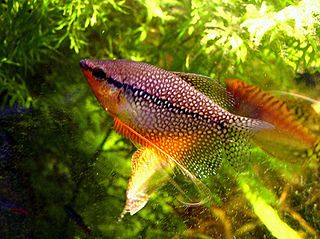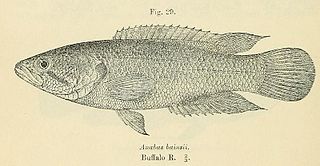
The pearl gourami is a species of gourami native to Southeast Asia.

Microctenopoma ansorgii is a small freshwater fish, known in the aquarium trade as the ornate ctenopoma, orange ctenopoma, ornate climbing perch, pretty ctenopoma, or rainbow ctenopoma. It is related to the more familiar spotted climbing perch, but looks very different. Its body is more elongated and rounded, with fins with red and black stripes; the color intensifies when the fish are displaying, with black bars becoming visible on the body. The ornate ctenopoma spawns at night, laying its eggs on a floating bubble nest like its relatives in the osphronemidae. It lives in the slow-flowing forest streams of the Congo Basin, where it feeds on worms, insect larvae, and other aquatic invertebrates. It is the most common member of its genus in the aquarium trade, where it is known for being a shy, easily bullied fish that needs live or frozen foods and which benefits from the presence of smaller dither fish to encourage it to come out of hiding.

Betta chini is a species of gourami endemic to the island Borneo where it is only known from the Malaysian state of Sabah. It inhabits very shallow waters of peat swamps. Males of this species can reach a length of 5.1 centimetres (2.0 in) SL while females can reach a length of 5.6 centimetres (2.2 in).

The ornate paradisefish or spotted gourami, is a species of gourami endemic to Sri Lanka. It is the only recognized species in its genus.
Microctenopoma damasi is a species of fish in the family Anabantidae. It is found in the Democratic Republic of the Congo and Uganda. Its natural habitat is rivers. This species was formally described in 1939 as Anabas damasi by the Belgian ichthyologist Max Poll, the type locality given was Semliki River at Ishango in the Democratic Republic of Congo. The type was collected by Hubert Damas (1910-1964) of the University of Liège and when he described the species Poll named Damas as co-author, this meant that Damas was the co-author of a specific name which honoured himself.

Nothobranchius korthausae is a species of killifish in the family Nothobranchiidae. It is endemic to Mafia Island in Tanzania. Its natural habitat is pools, ditches and small streams. The specific name of this species honours the German aquarist Edith Korthaus who collected the type.

Pachypanchax sparksorum is a species of Aplocheilid killifish endemic to Madagascar where it is found in the Anjingo River and streams feeding into the Ankofia River. Its natural habitat is rivers. The specific name of this fish honours the ichthyologist John S. Sparks of the United States National Museum and his wife Karen Riseng Sparks, they collected many of the type series.

The Eastern Province rocky, also known as rocky kurper, is a species of fish in the family Anabantidae. It is endemic to South Africa.

Betta enisae is a species of gourami endemic to the Kapuas River basin of Indonesia. It is an inhabitant of forest streams with slightly acidic waters, and can mostly be found in the shallows amongst the leaf litter. This species grows to a length of 5.9 cm (2.3 in). It is commonly used as bait by local fishermen and has been found in the aquarium trade. The specific name of this fish honours Enis Widjanarti who assisted Kottelat in his expedition to the Kapuas Lakes.
Petroscirtes thepassii, the Thepas' sabretooth blenny or the Thepas' fangblenny, is a species of combtooth blenny found in the western central Pacific ocean. This species reaches a length of 5.9 centimetres (2.3 in) SL. The specific name of this blenny honours the collector of the type, the military surgeon A.H. Thepass.

Betta edithae is a species of gourami endemic to Indonesia where it occurs in Kalimantan, Sumatra and the Riau Archipelago. This species grows to a length of 8.2 cm (3.2 in), and can be found in the aquarium trade. The specific name honours the German aquarist Edith Korthaus (1923-1987), who co-discovered this species with her husband Walter Foersch. Walter is honoured in the specific name of another species they discovered, Betta foerschi.

Betta tussyae is a species of gourami endemic to Malaysia where it is only known from Pahang. It is an inhabitant of peat swamps. This species grows to a length of 3.7 centimetres (1.5 in) SL. The specific name honours Tussy Nagy, the wife of the Austrian aquarist Peter Nagy, because in 1979 this couple were the first fish collectors to import this species into Europe.
Betta foerschi is a species of gourami endemic to the island of Borneo, where it is only known from the southern portion. It inhabits creeks in the rain forest. This species grows to a length of 7 cm (2.8 in). It can be found in the aquarium trade. The specific name of this fish honours the German physician and aquarist Walter Foersch (1932–1993), who collected the type with his wife Edith Korthaus. Edith is honoured in the specific name of another species they discovered, Betta edithae.
Betta waseri is a species of gourami endemic to Peninsular Malaysia. It is an inhabitant of well shaded blackwater streams and in peat forests with plentiful organic debris and root growth. This species grows to a length of 9.8 centimetres (3.9 in) SL. The specific name honours the leader of the expedition on which the type of this species, the German aquarist Alfred Waser.

The Malay combtail is a species of gourami native to southeast Asia where it is found in peat swamps of the Malay Peninsula and the Greater Sunda Islands. This species can reach a length of 20 centimetres (7.9 in) SL. It is a commercially important species and is also found in the aquarium trade. This species was formally described by Georges Cuvier in 1831 with the type locality of Java. The collector of the type was collected in 1820 by the Dutch physician and biologist Johan Coenraad van Hasselt (1797–1823), whom Cuvier honoured in its specific name, with his friend Heinrich Kuhl.

the African leaffish is a species of African leaffish native to fresh waters of western Africa. Although placed in the family Nandidae by FishBase and by the 5th Edition of Fishes of the World many recent authorities place Polycentropsis in Polycentridae.
Pristolepis grootii, commonly known as the Indonesian leaffish, is a fish native to streams of the Indonesian islands of Sumatra, Bangka, Belitung and Borneo, and Thailand. It is part of the first Western Indonesian and Sulawesi Freshwater fish species recorded by December 31, 1991 along with another 963 species. Further research lead to the discovery of other 79 fish species in the area. By May 31, 1996 deletions and additions were made revealing a grand total of 1032 known fish species in the area. The specific name honours the Dutch naturalist and ethnographer Cornelis de Groot van Embden (1817-1896).
Channa stewartii is a species of dwarf snakehead in the family Channidae, which is native to Nepal and the Indian states of Arunachal Pradesh, Assam, Manipur, Meghalaya, Nagaland and Tripura. It may also be found in Bangladesh. This freshwater fish mostly inhabits hill streams, but can also be found in ponds. It is of little value as a food fish but common in the aquarium trade.

The licorice gourami is a species of freshwater ray-finned fish from the subfamily Macropodusinae, part of the family Osphronemidae, the gouramis. It is endemic to Bangka in Indonesia where it is found in the slow, flowing streams with black waters associated with peat swamp forests. This species was formally described by the Dutch ichthyologist Pieter Bleeker as Osphromenus deissneri in 1859 with the type locality given as Sungai Baturussa basin at 8 kilometres from Pudingbesar on the road to Kampong Simpan, Bangka. It is the type species of the genus Parosphromenus. The specific name honours F. H. Deissner, a military health officer, who sent a collection of specimens of fishes from Bangka to Bleeker which included the type of this species.

Pseudosphromenus dayi or Indian spiketail betta is a species of freshwater ray finned fish from the subfamily Macropodusinae, part of the gourami family Osphronemidae. It occurs in Kerala on both the coastal regions and the Western Ghats. It is a species of still or slow flowing waters, especially lakes, ditches and swamps in both fresh and brackish waters. Pseudosphromenus dayi is a bubble nester, the male creates a nest made of bubbles under an overhang or a leaf. The females lays eggs which drop to the substrate and are picked up by both fishes in the pair and placed in the bubble nest. The name Polyacanthus cupanus dayi was first published in 1908 by Köhler in 1908 but Catalog of Fishes refers to this as a nomen nudum and attributes the valid use of the name, with a formal description, to P. Engmann in 1909. The type locality is given as Malacca which is probably an error and should be Kerala. The specific name honors the British ichthyologist and author of the Fishes of India, Francis Day (1830–1889).















